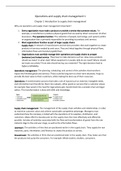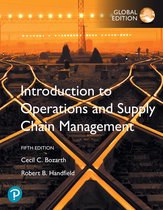Operations and supply chain management 1
Chapter 1 Introduction to supply chain management
Why are operations and supply chain management important?
1. Every organization must make a product or provide a service that someone values. For
example, a manufacturer produces physical goods that are used by direct consumers of other
businesses. The operation function: The collection of people, technology, and systems within
an organization that is primarily responsible for providing its products and services.
2. Most organizations function as part of larger supply chains.
Supply chain: A network of manufactures and services providers that work together to create
products of services needed by end-users. They are linked together through physical flows,
information flows and monetary (geld) flows.
3. Organizations must carefully manage their operations and supply chains to prosper
(welvaren) and indeed service. They have to make decisions such as: How many products
should we make? in what style? What equipment or people skills do we need? Where should
we locate our plants? From who should we buy our materials? The right decisions lead to
higher profitability.
Operations management: The planning, scheduling, and control of the activities that transform
inputs into finished goods and services. These could be long-term to short-term decisions. Hope to
provide the best value to their customers, while making the best use of their resources.
Operations: A transformation process that takes a set of inputs (such as material, intangible needs,
and information) and transforms them into outputs, either goods or services that a customer values.
An example: Raw wood or the need for legal advice gets transformed into a wooden chair and legal
advice. This transformation is done with skills and knowledge.
Supply chain management: The management of the supply chain activities and relationships, in order
to maximize customer value and achieve sustainable competitive advantage. Managers must
understand how the company is linked with the operations of its suppliers, distributors, and
customers. Make effort to develop and run the supply chain the most effectively and efficiently
possible. Includes all activities associated with the flow and transformation of goods from the raw
material stage to the end-user stage, as well as the information flows.
Upstream: The activities or firms that are positioned earlier in the supply chain. They supply the raw
materials, parts, information, and finances to create the product or service.
Downstream: The activities or firms that are positioned later in the supply chain. They make sure that
the products end up by the consumers. For example: Whole sealers, retailers, consumers.
, First-tier supplier: The
supplier that provides
products directly to a
firm.
Second-tier supplier: The
supplier that provides
products or services to a
firm’s first supplier.
For example: Making
Coca Cola in cans. Supplier 1 provides aluminum and ships it to provider 2. Provider 2 converts the
aluminum into cans and delivers it to the firm that makes Coca-Cola. Provider 2 is the first-tier
supplier because it directly supplies to Coca-cola. Supplier 1 is the second-tier supplier because it first
supplies to provider 2.
Supply chain operation reference model (SCOR): A model that provides standard descriptions of the
processes, relationships, and statistics that define supply chain management. It focusses on:
1. Planning activities: balance the demand requirements against the resources and
communicate these plans to the participants.
2. Sourcing activities: identifying, developing, and contracting with suppliers and scheduling the
delivery of incoming goods and services.
3. Production activities: The actual production of the goods and services.
4. Delivery activities: Entering customer orders, setting delivery dates, storing and moving
goods to their final destination.
5. Return activities: Activities necessary to return and process defective products or materials.
Differences between operation management and supply chain management:
Operations management focuses on the activities the company has to do to manage its own
company. It only focuses on its own company. While supply chain management focuses on the
relationships and activities of the suppliers, distributors, and customers.
Logistics management: A part of the supply chain management that plans, implements, and controls
the efficient and effective forward and reverse flows, storage of the goods and services, and related
information that is important to meet the customers’ requirements.
Trends in operations and supply chain management:
Agility: (behendigheid) The ability to quickly respond to changes in demand and supply and
still deliver the same or comparable cost, quality, and customer service. For example:
interruptions in the supply chain, launching new products due to market changes.
Information technologies: In the past 25 years information technology and electronic
commerce have had a big impact on business. Electronic commerce/ E-commerce: The use of
computer and telecommunication technologies to conduct business via electronic transfer of
data and documents.
People: The current shortage of talented operations and supply chain professionals.
, Chapter 2 Operations and supply chain strategies
Elements of business strategy:
Structural element: Tangible resources such as buildings, equipment, information technology
(computer systems). These resources require large capital investments and are hard to
reverse. For example classrooms, laboratories, athletic facilities.
Infrastructural element: The people, policies, decision rules, and organizational structure
choices made by the firm. How the company uses the structural elements. For example
feeding and housing students, assigning carpark places. Planning and controlling,
improvement…
Strategies: A mechanism by which a business coordinates its decisions regarding structural and
infrastructural elements. Long-term game plans.
The top-down model of strategy:
Mission statement: What an organization is trying to achieve. A statement that explains why an
organization exists. It describes the core values (what is important to the organization) and it
identifies the organization’s domain. (domein) What the organization is trying to achieve.
Business strategy: A strategy that identifies a firm’s targeted customers and indicates what value you
need to provide them. Set time frames and performance objectives and identify and develop the
core skills of the company.
Core competency: (vaardigheden) Organizational strengths or abilities, developed over a long period,
that customers find valuable and competitors find difficult or even impossible to copy.
Functional strategy: How the company is achieving its goals. Translates a business strategy into
specific actions for functional areas, such as marketing, human resources, and finance. How the
organization is going to achieve its goals.






